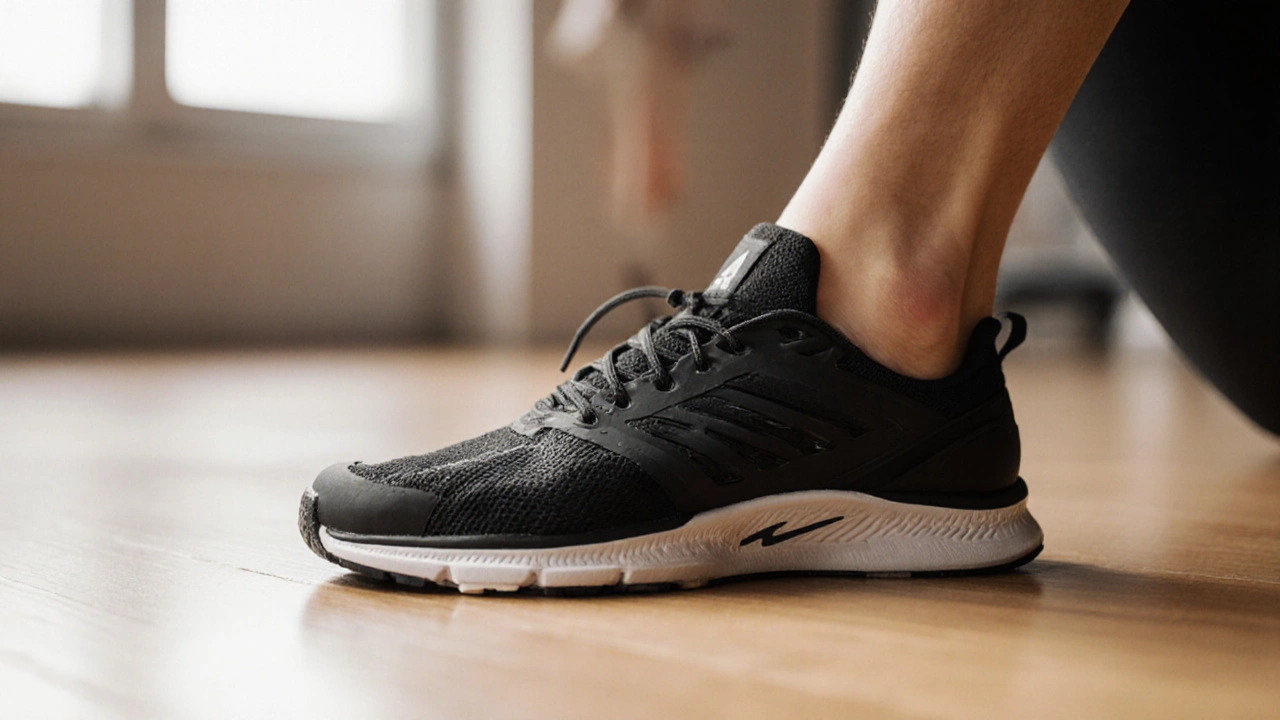Should You Buy Running Shoes a Size Bigger? The Real Answer

Running Shoe Fit Calculator
Find Your Perfect Fit
Get the right size for your running shoes based on science, not myths.
Your Recommended Size
Recommended Size
Why?
Proper Fit Checklist
- Toe room: About 1/2 inch (thumb's width) between toes and shoe front
- Heel fit: Heel stays locked in place without slipping
- Width: Toes have space without being cramped
Most runners have been told at least once: buy running shoes a size bigger. But is that advice actually right? Or is it just a myth that’s been passed down from one runner to the next? If your toes hit the front of your shoes on downhill runs, or your heels slip after a few miles, you’re not alone. But sizing up isn’t always the fix-and sometimes, it makes things worse.
Why People Think Bigger Shoes Are Better
The idea comes from a simple observation: your feet swell during a run. That’s normal. Blood flows to your toes, muscles expand, and your arches flatten slightly under impact. In a long race or a hard training session, your feet can grow by up to half a size. That’s why some people swear by going up a full size-they want room for that expansion. But here’s the problem: your foot doesn’t grow evenly. The ball of your foot and your toes stretch forward, but your heel stays put. If you buy shoes that are too big, your heel slips. Your foot slides around inside the shoe. That causes blisters. It changes your stride. It makes your knees and hips work harder to stabilize your movement. A 2023 study from the University of Calgary’s Biomechanics Lab tracked 120 runners over 12 weeks using pressure-sensing insoles. Runners who wore shoes that were one full size too big reported 37% more heel slippage and 22% more metatarsal pain compared to those who wore properly fitted shoes. The extra space didn’t help-it hurt.What a Properly Fitted Running Shoe Should Feel Like
You don’t need a shoe that feels loose. You need one that feels secure but not tight. Here’s what to check:- Toe room: There should be about a thumb’s width (roughly 1/2 inch or 1.3 cm) between your longest toe and the end of the shoe. That’s enough space for swelling without letting your foot slide.
- Heel fit: Your heel shouldn’t lift when you walk or run. If it does, the shoe is too big-even if your toes feel cramped.
- Width: Your foot should feel hugged, not squeezed. If your toes are squished together or you feel pressure on the sides, you might need a wider width, not a longer length.
- Arch support: The shoe should match your arch type. Too much or too little support can make your foot feel unstable, which might make you think you need more room.
Try this test: lace up your shoes, go for a 10-minute walk, then jog in place. If your foot moves inside the shoe, it’s too big. If your toes feel pinched, it’s too small. If you feel secure and your toes have wiggle room, you’ve got it right.
When Going Up Half a Size Makes Sense
There are exceptions. If you’re training for a marathon, doing long trail runs, or running in hot weather, your feet will swell more than usual. In those cases, going up half a size can help. For example, runners in Calgary who train through winter often wear thicker socks. If you normally wear a size 9, you might need a 9.5 when you’re layering in wool running socks. But that’s not because your foot grows-it’s because the sock adds bulk. Same goes for trail running. On steep descents, your toes slam into the front of the shoe. A little extra space up front helps prevent black toenails. But again, half a size is enough. A full size? That’s overkill.
What Happens When Shoes Are Too Big
Wearing shoes that are too big doesn’t just feel awkward-it changes how your body moves.- Heel slippage: Causes blisters, especially on the back of your heel or Achilles tendon.
- Overpronation: A loose shoe lets your foot roll inward too much, straining your plantar fascia and shin muscles.
- Reduced energy return: Your foot isn’t locked in, so the shoe can’t push back efficiently when you stride.
- Increased injury risk: Studies show runners with ill-fitting shoes are 2.3 times more likely to develop plantar fasciitis or stress fractures.
One runner I know from Calgary started buying shoes two sizes up after a blister ruined her half-marathon. She thought it would help. Instead, she developed chronic knee pain. Her podiatrist told her: “You’re not giving your foot room to swell-you’re giving it room to wobble.”
How to Find Your Perfect Fit
Don’t guess. Test. Here’s how:- Go shoe shopping in the afternoon or evening. That’s when your feet are at their largest.
- Wear the same socks you’ll run in. Not your casual socks. Not your thinnest ones. The ones you actually train in.
- Stand up and press your big toe against the front of the shoe. Slide your finger behind your heel. You should feel a snug fit with a little space-about the width of your finger.
- Walk, then jog around the store. Pay attention to your heel and toes. Do they move? Does anything pinch?
- Don’t rely on your usual size. A size 8 in Nike might be a 8.5 in Brooks. Sizes vary by brand.
Most running stores have trained staff who use a Brannock device to measure both length and width. Use them. It’s free. And it’s more accurate than eyeballing it.
What About Toe Box Width?
Sometimes, the problem isn’t length-it’s width. If your toes are squished side-to-side, no amount of length will fix that. You need a wider shoe. Brands like Altra, Hoka, and New Balance offer wide and extra-wide models. If you have flat feet, bunions, or naturally wide feet, a wider toe box gives you the space you need without making the shoe too long.Try this: stand barefoot on a piece of paper. Trace your foot. Now compare it to the shape of the shoe’s interior. If your foot spills over the sides, you need a wider model-not a longer one.
Myth Busting: Do Your Toes Need to Touch the End?
No. Your toes should never touch the front of the shoe-even when you’re running. That’s how black toenails happen. But they also shouldn’t be floating in space. That’s how blisters happen. The sweet spot? A thumb’s width. That’s it. That’s the rule used by most professional running coaches and podiatrists. It’s not a suggestion. It’s a standard.Final Rule: Fit for Function, Not Fear
Don’t buy bigger shoes because you’re afraid your feet will hurt. Buy the right size because you want your feet to feel good. If your current shoes feel tight, try a different brand. If they feel loose, go down a half size. Don’t assume bigger is better. Your feet aren’t balloons. They don’t need extra room to breathe. They need support, stability, and a snug fit.Running shoes are tools. You wouldn’t use a hammer that’s too big for your hand. Don’t use shoes that are too big for your feet.
Should I buy running shoes a size bigger than my regular shoes?
No, not necessarily. Your running shoe size may be the same as your regular shoe size, or it might be half a size larger. The key is fit, not size. Your foot should have about a thumb’s width of space in front of your longest toe, and your heel should stay locked in place. Don’t rely on your everyday shoe size-always try on running shoes with your running socks.
Why do my toes go numb in running shoes?
Numb toes usually mean your shoes are too tight, not too loose. If the toe box is too narrow or the laces are tied too tightly, they cut off circulation. Try a wider shoe or loosen your laces around the forefoot. If you’re wearing a size bigger to fix this, you’re solving the wrong problem.
Is it better to have running shoes too big or too small?
Neither. But if you have to choose, slightly too small is worse. Shoes that are too small cause blisters, black toenails, and nerve damage. Shoes that are too big cause heel slippage, instability, and knee pain. The goal is perfect fit-not compromise.
Do running shoes stretch out over time?
Some materials, like mesh or knit uppers, will stretch a little-maybe a quarter size. But the midsole and heel counter won’t. Don’t buy tight shoes thinking they’ll stretch. If they feel tight at the store, they’ll stay tight or get worse. Fit should be right from day one.
How often should I replace my running shoes?
Most runners replace shoes every 300 to 500 miles. After that, the cushioning breaks down, and the shoe loses its shape. Even if they look fine, they’re no longer protecting your feet. Wearing worn-out shoes is the #1 reason runners get injuries-not wrong sizing.

